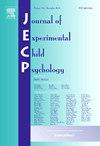儿童符号和非符号数字信息的整合:任务依赖及其与数学能力的联系
IF 1.8
2区 心理学
Q3 PSYCHOLOGY, DEVELOPMENTAL
引用次数: 0
摘要
从出生开始,孩子们就能接触到近似数字系统来进行有噪声的数值估计。随着年龄的增长,他们掌握了精确的数字系统来精确地表示数字信息。这两种系统之间的关系及其与儿童数学能力的相关性尚不清楚。在本研究中,8- 10岁的儿童(N = 119)完成了两个任务,以测试符号和非符号数字信息的整合(即“符号整合”)以及这种整合与儿童形式数学能力的关系。在涉及点阵和阿拉伯数字的数字比较任务中,儿童指出两种顺序呈现的刺激中哪一种更大。这些刺激要么是相同的格式(点-点或数字-数字),要么是混合格式(点-数字或数字-点)。对于数字-字母辨别任务,参与者识别与数字数量匹配或不匹配的点数组同时出现的数字或字母对。在数字比较任务中,我们发现儿童在比较混合格式刺激时比在比较相同格式刺激时反应明显慢,这表明儿童缺乏符号整合(即“符号隔阂”)。相比之下,在数字-字母辨别任务中,儿童在点阵和数字匹配的任务中明显更快,这表明符号整合。虽然我们发现在这两项任务的条件水平上,数字处理和数学技能之间存在相关性,但符号隔阂或符号整合的衍生测量都与儿童在标准化数学评估中的表现无关。因此,我们得出结论,数字整合或隔阂是任务依赖的,符号整合对8- 10岁儿童的数学能力影响有限。本文章由计算机程序翻译,如有差异,请以英文原文为准。
Integration of symbolic and non-symbolic numerical information in children: Task dependence and its link to math abilities
From birth, children can access the approximate number system for noisy numerical estimates. With age, they acquire an exact number system for precise numerical information representation. The relations between these two systems and their correlations with math abilities in children remain unclear. In this study, 8- to 10-year-old children (N = 119) completed two tasks to test the integration of symbolic and non-symbolic numerical information (i.e., “symbolic integration”) and how this integration relates to children’s formal math abilities. For the number comparison task, involving dot arrays and Arabic numerals, children indicated which of two sequentially presented stimuli was larger. These stimuli were either in the same format (dot–dot or numeral–numeral) or in a mixed format (dot–numeral or numeral–dot). For the number–letter discrimination task, participants identified numerals or letter pairs co-occurring with dot arrays that either matched or mismatched the numeral’s quantity. In the number comparison task, we found that children were significantly slower when comparing mixed-format stimuli versus same-format conditions, suggesting a lack of symbolic integration (i.e., “symbolic estrangement”). In contrast, in the number–letter discrimination task, children were significantly faster in tasks where the dot arrays and numerals matched, indicating symbolic integration. While we found correlations between number processing and math skills at the condition level for both tasks, neither of the derived measures of symbolic estrangement or symbolic integration correlated with children’s performance on a standardized math assessment. Thus, we conclude that numerical integration or estrangement is task dependent and that symbolic integration has limited impact on 8- to 10-year-old children’s math abilities.
求助全文
通过发布文献求助,成功后即可免费获取论文全文。
去求助
来源期刊

Journal of Experimental Child Psychology
Multiple-
CiteScore
4.50
自引率
7.70%
发文量
190
期刊介绍:
The Journal of Experimental Child Psychology is an excellent source of information concerning all aspects of the development of children. It includes empirical psychological research on cognitive, social/emotional, and physical development. In addition, the journal periodically publishes Special Topic issues.
 求助内容:
求助内容: 应助结果提醒方式:
应助结果提醒方式:


